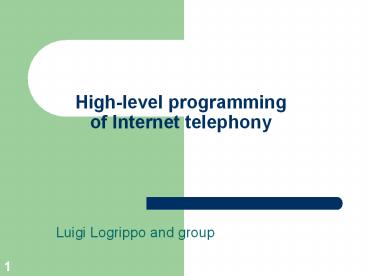High-level programming of Internet telephony - PowerPoint PPT Presentation
Title: High-level programming of Internet telephony
1
High-level programming of Internet telephony
- Luigi Logrippo and group
2
Project Objectives Addressed
- Area A To develop the available notations to
specify requirements (Sincennes) - Area B To develop innovative methods and tools
that can be used for the development of correct
and secure system design models from a given
specification of the requirements, considering in
particular the possibilities for automating
certain parts of the design process (Sincennes) - Area C To develop innovative formal validation
methods and tools appropriate for this process
(Xu) - Area D To evaluate the notations, methods and
tools by applying them to realistic examples of
distributed systems, especially in the area of
service development in internet telephony (Jiang,
Sincennes, Xu)
3
Main areaProgramming Internet telephonyfor new
and old features
- CPL is proposed, but it is very limited and
low-level - Define new languages that are
- Closer to user requirements level
- But still executable or compilable into
executable - More appropriate for flexible and general
features - Allow VV activities such as Feature Interaction
detection and resolution
4
Project 1 Feature Execution Trees(Jacques
Sincennes) (Areas A,B available and innovative
nots., applics.)
- Initial idea due to Mitel group (Tom Gray,
others) - Tuple space is an idealized database where
pertinent system state information is stored - In reality, it could be implemented as a number
of data bases - Telecom features can be described as decision
trees that take their input from a tuple space
and a current trigger, and decide on a sequence
of actions - Being developed by Jacques Sincennes as a
language based on logic programming and Prolog - Avantages
- Clear logic, probably appropriate for VV based
on theorem proving - Executable, because Prolog is executable
- Prolog mechanism is not visible to user, who uses
high-level primitives
5
Project 2 Feature Interaction in CPL(Yiqun Xu)
(Area C formal validation)
- CPL Call Processing Language
- an IETF CFP capable of describing simple
telephony features - What kinds of feature interactions are possible
among features described in CPL? - Interactions within one script
- shadowing, etc.
- Interactions between scripts
- A call that should be impossible according to the
policy of one user, or system policies, becames
possible because of the policy of another - Global invariants violated
6
Project 2 Feature Interaction in CPL(Yiqun Xu)
(Area C)
- Being developed
- Translator from CPL representation in XML into a
logic-based language - System to find interactions and flag them for the
user - Interesting questions interactions between CPL
scripts become possible only when CPL scripts
interwork - How to detect this possibility in a world where
there may be as many CPL scripts as there are
users?
7
Project 3CPL extensions(Dongmei Jiang) (Area D
applics)
- CPL extensions for presence
- Use of tuple space that contains presence
information - What each user is available for
- in a meeting, in a specific room, wanting to
receive only certain types of messages - Availability and notification of presence
information - User sets up features by using templates, these
become programs for agents































